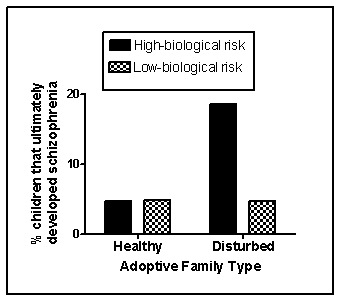Scenario II
The following scenario presents fabricated data consistent with the results of the following study:
Tienari, P., Wynne, L. C., Sorri, A., Lahti, I., Läksy, K., Moring, J., & ... Wahlberg, K. (2004) . Genotype-environment interaction in schizophrenia-spectrum disorder: Long-term follow-up study of Finnish adoptees. The British Journal of Psychiatry, 184(3) , 216-222. doi:10.1192/bjp.184.3.216
Schizophrenia affects approximately 1 percent of the general population and is characterized by the profound disruption of basic psychological processes; a distorted perception of reality;, altered or blunted emotional affect; and disturbances in thought, motivation, and behavior. The symptoms of schizophrenia are varied and are typically classified as either positive or negative. Positive symptoms of schizophrenia refer to thoughts and behaviors typically not observed in those without the disease, and can include things like delusions (patently false beliefs) , hallucinations (false perceptual experiences) , and disorganized speech. Negative symptoms of schizophrenia are deficits or disruptions in normal behaviors, such as social withdrawal. Cognitive deficits in executive functioning, attention span, and working memory also may be observed.
The symptoms of schizophrenia usually begin in late adolescence and the disease has a strong genetic component. Over the years, a number of biological factors have been linked to schizophrenia, although none alone adequately accounts for the disorder. One such example is the dopamine hypothesis, which states that schizophrenia is related to an excess in dopamine activity. Another theory points to enlarged brain ventricles and progressive cortex tissue loss as predictive of schizophrenia, although only a minority of persons with schizophrenia have enlarged ventricles, this structural anomaly can appear in those without the disease, and dopamine antagonists also may produce this effect.
Although research into the environmental determinants of schizophrenia has focused largely on the prenatal environment, psychological and social factors also contribute. Tienari et al. (2004) compared the risk of developing schizophrenia in children adopted into healthy versus disturbed families, the latter characterized by extreme conflict, volatile relationships, and communication deficits. Some of these children under investigation were identified as at-risk genetically for schizophrenia because their biological mothers were schizophrenic. The remainder was classified at low risk. The investigators utilized a longitudinal design and obtained the diagnostic status of the children with respect to schizophrenia when they reached young adulthood. Fabricated results consistent with this study are shown in Figure 15.2
Figure 15.2 
-(Scenario II) Numerous studies have demonstrated enlarged ventricles in patients with schizophrenia, particularly those exhibiting the negative symptoms of the disease. Interpretation of this finding is complicated for all of these reasons EXCEPT:
Definitions:
Invisible Hand
A term coined by Adam Smith to describe the self-regulating nature of the marketplace, where individual self-interest beneficially contributes to societal welfare.
Tao Te Ching
A foundational text of Taoism, attributed to Laozi, emphasizing living in harmony with the Tao, or the fundamental nature of the universe.
Aggressive Measures
Actions or policies that are forceful and intended to achieve a particular outcome, often used in contexts like law enforcement or military strategy.
Shadowy Presence
An ambiguous or unclear force, entity, or influence that impacts events or situations without being directly observable or fully understood.
Q3: The psychodynamic approach to therapy generally focuses
Q5: A person who got married, had a
Q15: General practice physicians receive extensive experience in
Q23: Self-regulation is more effective when it focuses
Q24: Which of these is NOT recognized by
Q82: Many people engage in self-injury as a
Q92: The deinstitutionalization movement of the 1960s, in
Q103: Which of these treatment illusions need not
Q118: The phase of the general adaptation syndrome
Q124: Psychoanalysts use all of these methods to